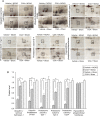Chlorogenic acid modulates the ubiquitin-proteasome system in stroke animal model
- PMID: 36539905
- PMCID: PMC9768937
- DOI: 10.1186/s42826-022-00151-2
Chlorogenic acid modulates the ubiquitin-proteasome system in stroke animal model
Abstract
Background: Chlorogenic acid, a phenolic compound, has potent antioxidant and neuroprotective properties. The ubiquitin-proteasome system is an important regulators of neurodevelopment and modulators of neuronal function. This system is associated with neurodevelopment and neurotransmission through degradation and removal of damaged proteins. Activation of the ubiquitin-proteasome system is a critical factor in preventing cell death. We have previously reported a decrease in the activity of the ubiquitin-proteasome system during cerebral ischemia. This study investigated whether chlorogenic acid regulates the ubiquitin-proteasome system in an animal stroke model. In adult rats, middle cerebral artery occlusion (MCAO) surgery was performed to induce focal cerebral ischemia. Chlorogenic acid (30 mg/kg) or normal saline was injected into the abdominal cavity 2 h after MCAO surgery, and cerebral cortex tissues were collected 24 h after MCAO damage.
Results: Chlorogenic acid attenuated neurobehavioral disorders and histopathological changes caused by MCAO damage. We identified the decreases in ubiquitin C-terminal hydrolase L1, ubiquitin thioesterase OTUB1, proteasome subunit α type 1, proteasome subunit α type 3, and proteasome subunit β type 4 expression using a proteomics approach in MCAO animals. The decrease in these proteins was alleviated by chlorogenic acid. In addition, the results of reverse transcription-polymerase chain reaction confirmed these changes. The identified proteins were markedly reduced in MCAO damage, while chlorogenic acid prevented these reductions induced by MCAO. The decrease of ubiquitin-proteasome system proteins in ischemic damage was associated with neuronal apoptosis.
Conclusions: Our results showed that chlorogenic acid regulates ubiquitin-proteasome system proteins and protects cortical neurons from neuronal damage. These results provide evidence that chlorogenic acid has neuroprotective effects and maintains the ubiquitin-proteasome system in ischemic brain injury.
Keywords: Cerebral ischemia; Chlorogenic acid; Neuroprotection; Ubiquitin–proteasome system.
© 2022. The Author(s).
Conflict of interest statement
The authors declare that there is no financial conflict of interests to publish these results.
Figures



Similar articles
-
Retinoic acid regulates the ubiquitin-proteasome system in a middle cerebral artery occlusion animal model.Lab Anim Res. 2022 May 13;38(1):13. doi: 10.1186/s42826-022-00123-6. Lab Anim Res. 2022. PMID: 35562751 Free PMC article.
-
Chlorogenic acid alleviates neurobehavioral disorders and brain damage in focal ischemia animal models.Neurosci Lett. 2021 Aug 24;760:136085. doi: 10.1016/j.neulet.2021.136085. Epub 2021 Jun 24. Neurosci Lett. 2021. PMID: 34174343
-
Chlorogenic acid alleviates the reduction of Akt and Bad phosphorylation and of phospho-Bad and 14-3-3 binding in an animal model of stroke.J Vet Sci. 2022 Nov;23(6):e84. doi: 10.4142/jvs.22200. Epub 2022 Sep 30. J Vet Sci. 2022. PMID: 36259103 Free PMC article.
-
Role of the ubiquitin-proteasome system in brain ischemia: friend or foe?Prog Neurobiol. 2014 Jan;112:50-69. doi: 10.1016/j.pneurobio.2013.10.003. Epub 2013 Oct 22. Prog Neurobiol. 2014. PMID: 24157661 Review.
-
Proteasomes and Ubiquitin C-Terminal Hydrolase L1 as Biomarkers of Tissue Damage and Inflammatory Response to Different Types of Injury-A Short Review.Life (Basel). 2025 Mar 6;15(3):413. doi: 10.3390/life15030413. Life (Basel). 2025. PMID: 40141757 Free PMC article. Review.
References
LinkOut - more resources
Full Text Sources
Research Materials
Miscellaneous

